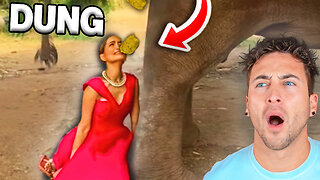Premium Only Content

Moon Phase and Libration South Up 2014
Lunar Reconnaissance Orbiter (LRO) has been in orbit around the Moon since the summer of 2009. Its laser altimeter (LOLA) and camera (LROC) are recording the rugged, airless lunar terrain in exceptional detail, making it possible to visualize the Moon with unprecedented fidelity. This is especially evident in the long shadows cast near the terminator, or day-night line. The pummeled, craggy landscape thrown into high relief at the terminator would be impossible to recreate in the computer without global terrain maps like those from LRO.
The Moon always keeps the same face to us, but not exactly the same face. Because of the tilt and shape of its orbit, we see the Moon from slightly different angles over the course of a month. When a month is compressed into 24 seconds, as it is in this animation, our changing view of the Moon makes it look like it's wobbling. This wobble is called libration.
The word comes from the Latin for "balance scale" (as does the name of the zodiac constellation Libra) and refers to the way such a scale tips up and down on alternating sides. The sub-Earth point gives the amount of libration in longitude and latitude. The sub-Earth point is also the apparent center of the Moon's disk and the location on the Moon where the Earth is directly overhead.
The Moon is subject to other motions as well. It appears to roll back and forth around the sub-Earth point. The roll angle is given by the position angle of the axis, which is the angle of the Moon's north pole relative to celestial north. The Moon also approaches and recedes from us, appearing to grow and shrink. The two extremes, called perigee (near) and apogee (far), differ by more than 10%.
The most noticed monthly variation in the Moon's appearance is the cycle of phases, caused by the changing angle of the Sun as the Moon orbits the Earth. The cycle begins with the waxing (growing) crescent Moon visible in the west just after sunset. By first quarter, the Moon is high in the sky at sunset and sets around midnight. The full Moon rises at sunset and is high in the sky at midnight. The third quarter Moon is often surprisingly conspicuous in the daylit western sky long after sunrise.
Celestial south is up in these images, corresponding to the view from the southern hemisphere. The descriptions of the print resolution stills also assume a southern hemisphere orientation.
-
 LIVE
LIVE
The Rubin Report
1 hour agoThe Exact Moment CNN Host Realizes Jasmine Crockett Is a Monster
1,605 watching -
 LIVE
LIVE
LFA TV
14 hours agoLIVE & BREAKING NEWS! | THURSDAY 11/20/25
3,009 watching -
 1:02:09
1:02:09
VINCE
3 hours agoThe Process Is The Punishment | Episode 173 - 11/20/25 VINCE
152K84 -
 UPCOMING
UPCOMING
Athlete & Artist Show
46 minutes agoBOMBASTIC Sports & Table Cames
3 -
 LIVE
LIVE
The Mel K Show
54 minutes agoMORNINGS WITH MEL K - The Battle for your Brain: Psychological Warfare on Full Throttle- 11-19-25
119 watching -
 UPCOMING
UPCOMING
The Shannon Joy Show
55 minutes agoTrump Says He’ll Import Foreign Workers To Make Chips * HHS Updates Website On Autism * LIVE With Tiffany Cianci On Predatory Private Equity & Incoming Pension Raid
28 -
 LIVE
LIVE
Grant Stinchfield
1 hour agoDOJ’s Salacious Distraction: The REAL Epstein Intel Is Locked in Langley!
89 watching -
 1:29:05
1:29:05
Nikko Ortiz
2 hours agoThis Is Gonna Hurt... | Rumble LIVE
5.57K -
 23:11
23:11
Simply Bitcoin
1 day ago $0.59 earnedThe Bitcoin Crucible w/ Alex Stanczyk & Tomer Strolight - Episode 9
14K -
 1:46:55
1:46:55
Benny Johnson
2 hours agoHow Good Your Life Could Be Under Trump's Mass Deportations | Citizens Cheer: 'AMERICANS First'
27.6K12